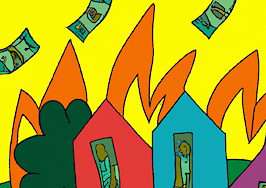After a decade of rapid home value growth, the equity-building boom is over, according to the latest report from Attom.
The share of homes that were worth at least 50 percent more than the mortgage on them fell for the second straight quarter in the first three months of 2023, the property data firm said.
Forty-seven percent of homes with a mortgage in the U.S. are considered equity-rich. That’s a slight dip from the final three months of 2022, as the nation was moving away from the pandemic-era housing market when home prices and equity skyrocketed.
It marked the end of a decade-long run of home price growth that included two years during the COVID-19 pandemic when home prices skyrocketed.
“The equity downturn, small as it was, stood as the latest indicator of how a decline in home prices across much of the country has started to affect homeowners following a decade-long market boom,” Attom said.
Few homes are seriously underwater
That doesn’t mean more homes are becoming distressed, as the number of seriously underwater mortgages was virtually unchanged in the quarter. A home is considered seriously underwater if the loans on it are at least 25 percent more than its value.
That may be in part because low inventory has kept prices from falling as much as they would, recent reports have said. Just 3 percent of mortgaged homes were seriously underwater in the quarter, virtually unchanged from the fourth quarter of 2022 and slightly below 3.2 percent in the first three months of last year.
And the share of people who have a significant amount of equity in their homes is still about twice as high as it was three years ago.
“Homeowners across the U.S. continue to sit in a far better position than they were just a few years ago, with historically elevated levels of wealth built up in their properties,” said Attom CEO Rob Barber. “The recent downturn in the housing market is chipping away at the bounty they reaped from a decade of price surges.”
Western U.S. leads in equity losses
After leading a surge in the COVID-19 housing market, the West continues to lead the nation during the slowdown.
The share of homes that were equity-rich in Arizona dropped from 59.9 percent in the fourth quarter to 56.4 percent in the first quarter of 2023.
In Nevada, the number fell from 52.3 percent to 49 percent. In Idaho, it dropped from 61.6 percent to 58.5 percent.
The only western state to see the share of equity-rich homes rise during the same time period was New Mexico, where the share climbed from 45.6 percent in the fourth quarter to 48.9 percent in the first.
The West is still home to seven of the 10 most equity-rich states.
Thirty-five percent of homes in Mississippi were considered equity-rich, and it’s 36.4 percent in Oklahoma and 40.2 percent in Kentucky.
Northeast leads growth in seriously underwater homes
Homes that were seriously underwater rose in Pennsylvania, Maine and Vermont.
South Dakota led the way nationally, where 4.3 percent of homes were worth at least 25 percent less than what was owed on them, according to the report.
“It’s still too early to call this a long-term trend, and there are reasons to hope for a market turnaround this year,” Barber said. “For now, though, various measures suggest that the best of the boom may be behind us.”
Incoming foreclosure wave unlikely
Attom’s report doesn’t suggest an incoming wave of foreclosure activity, as most homeowners who are at some stage of the foreclosure process have at least some equity, according to the report.
Of the 58.2 million outstanding mortgages in the U.S., 238,000 faced possible foreclosure in the first quarter. That’s less than half a percent of all mortgages.
Among the homeowners facing foreclosure, 92 percent had at least some equity in their homes.













